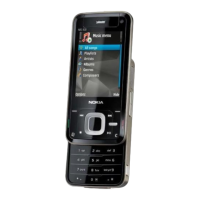• Oscilloscope
• Function generator (sine waveform)
• Current probe (Internal handsfree PWM output measurement)
• Phoenix service software
• Power supply 3.7V
Test procedure
Ausio can be tested using Phoenix audio routings option. Four different audio loop paths can be activated:
• External mic to external earpiece
• External mic to internal earpiece
• External mic to internal handsfree speaker (IHF, mono signal to both speakers)
• Internal mic to external earpiece
Each audio loop sets routing from the specified input to the specified output enabling a quick in-out test.
Loop path gains are fixed an can not be changed using phoenix. Correct pins an signals for each test see
following table.
Phoenix audio loop tests and test results
The results presented in the table apply, when no accessory is connected. Earpiece, internal mic and speaker
are in place during measurement. Applying a headset accessory during measurement causes a significant
drop in measured levels.
The gain values presented in table apply for differential output vs single ended input.
Loop test Input
terminal
Output
terminal
Path gain
[dB] fixed
Input
Voltage
[mVpp]
Differenti
al
outputvol
tage
[mVpp]
Output DC
level [V]
Output
current
Ext Mic ->
Ext Earp
HS-MIC &
GND
HSEARL&G
ND
-8.6 1000 367 1,2
HSEARR&
GND
Ext Mic ->
Int Earp
HS-MIC &
GND
EarP &
GND
-10 1000 310 1,2
EarN &
GND
Ext Mic ->
Int Hands
Free
XMICP &
GND
B2150
B2151 all
terminals
8,5 920 2520 0 ~25mA
each
XMICN &
GND
Int Mic ->
Int Hands
Free
Acoustica
l input,
1khz sine
wave
IHF
Speakerp
ad
94 dB SPL -
Measurement data
Earpiece signal
RM-179; RM-223
Baseband Troubleshooting
Page 3 –42 COMPANY CONFIDENTIAL Issue 1
Copyright © 2007 Nokia. All rights reserved.

